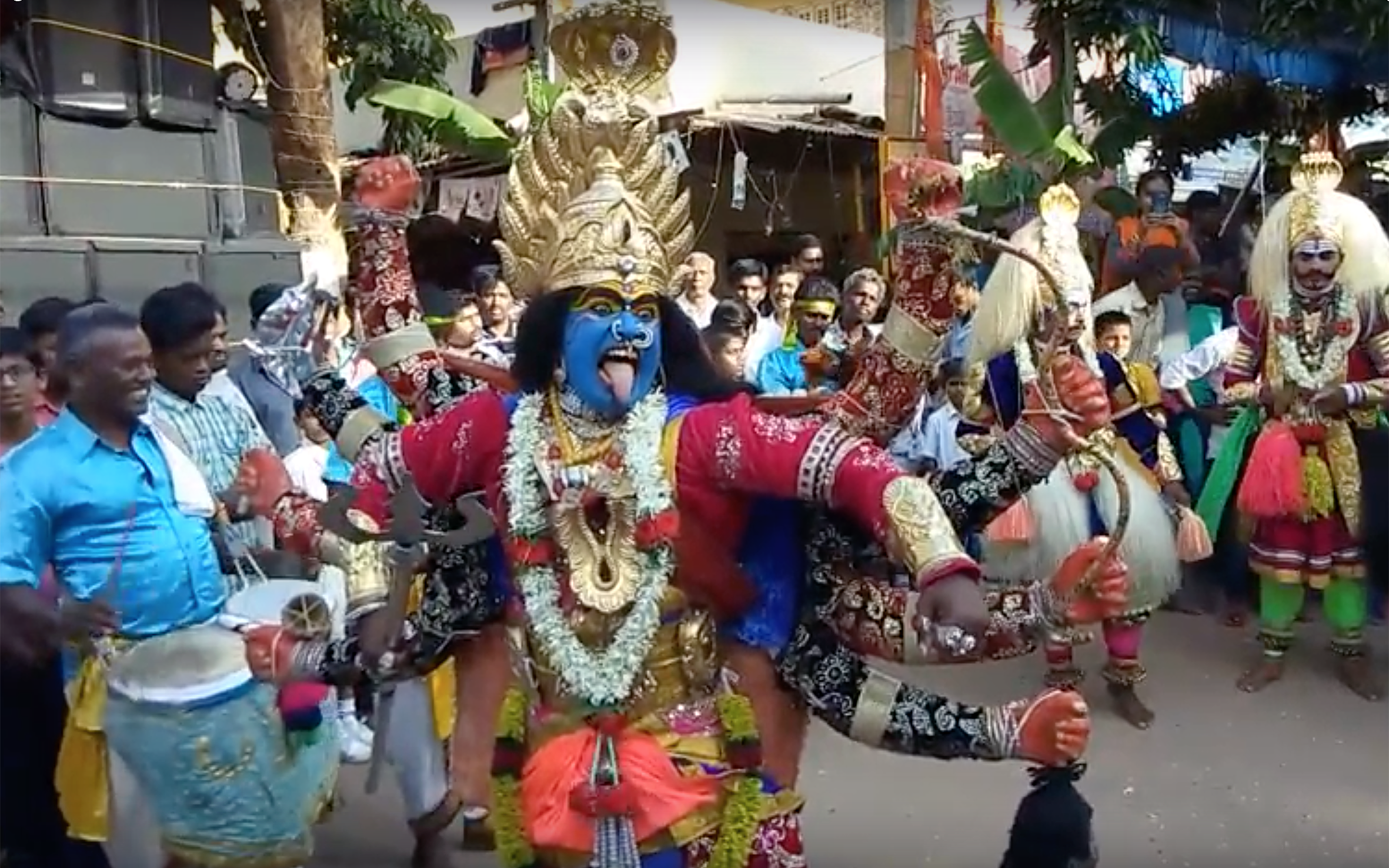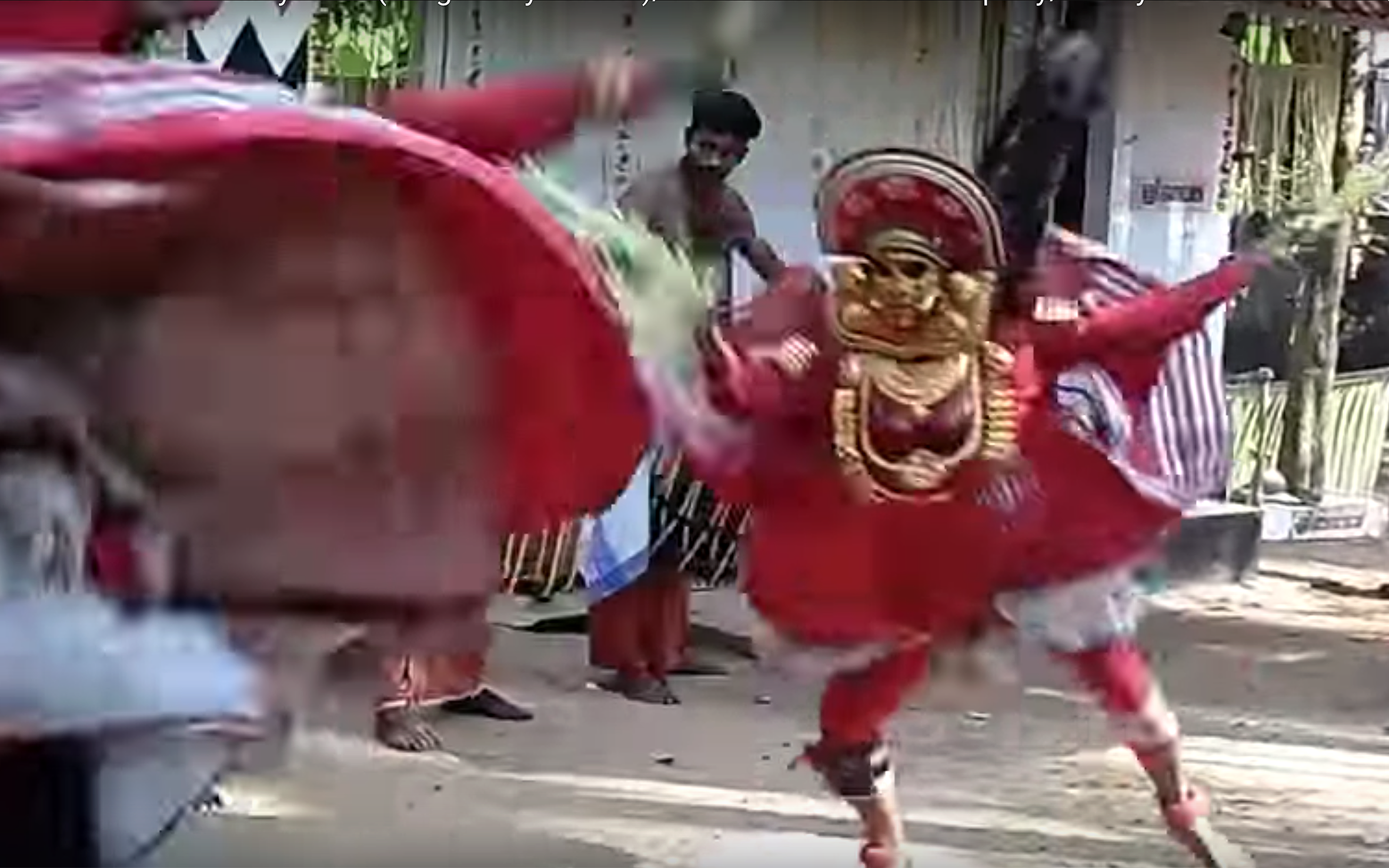937.Veeragase / India
VEERAGASE is a dance form prevalent in the state of Karnataka, India. It is a vigorous dance based on Hindu mythology, and it involves very intense energy-sapping dance movements. The dance is performed in the Dasara procession held in Mysore, as well as during various festivals, mainly in the Hindu months of Shravana and Karthika. It is danced in groups usually consisting of two, four or six members, sometimes holding swords in their hands. The dance also involves a ritualistic piercing of a needle across the mouth.
938.VELLATTU / India
VELLATTU is a dance originating from the south of India, performed as an invocative ritual prior to Theyyam. Through this ritual, the mortal dancer is believed to get transformed into the divine self.
939.Verbunkos / Hungary
VERBUNKOS is a Hungarian folk dance from the 18th century. The name is derived from the German word “Werbung”, which means “to recruit” and “verbunkos” is a “recruiter”. The dance is typically divided into two alternating sections: slow, with a characteristic dotted rhythm, and fast, with virtuosic running-note passages. It was played during military recruiting before the Habsburg Emperors, who were also Kings of Hungary, introduced conscription. The character of the music derives from the military march tempo. The melodies originate from Hungarian folk and popular music, and have been sometimes attributed to Gypsies, because the accompaniment was usually played by Gypsy musicians in their characteristic style.
940. VIKIVAKI / Iceland
VIKIVAKI is an old ring dance that has been celebrated throughout the Nordic Region from the Middle Ages until today and has been a crucial part of Icelandic society since its earliest times. It is danced in a circle, with the participants holding hands or each other’s shoulders and stepping two times to the left and once to the right, with various changes, such as stamping on the floor in every eighth step. The word “vikivaki” can be used either to describe the dance, the songs that are sung during the dance or the celebrations where such a dance is practiced.
941.VIMBUZA / Malawi
VIMBUZA is a spirit dance performed for healing, popular among the Tumbuka people living in northern Malawi. It is an important manifestation of the ng’oma, a healing tradition found throughout Bantu-speaking Africa. Ng’oma, meaning “drums of affliction”, carries considerable historical depth and, despite various attempts over the years to suppress it, remains a fundamental part of indigenous healthcare systems. The healing ritual dates back to the mid-19th century, when it developed as a means of overcoming traumatic experiences of oppression, specifically British occupation—although it was forbidden by Christian missionaries.
942.VIRA / Portugal
VIRA is a traditional dance from Portugal, most popular in the Minho region but performed also in other regions of the country. It has a three step rhythm very similar to waltz, but it is faster and the couples dance front-to-front without holding hands. It can also be danced in matched pairs forming a big circle that moves anticlockwise, while the dancers snap their fingers. At a certain point, the male dancers leave their pairs in the circle and go to the center, where they stamp their right feet and return to their respective pairs. The circle starts to rotate again, and the next time it stops, it is the female dancers that go to the center, and so on.
943. VIRAL DANCE / Global
VIRAL DANCE is a dance phenomenon that involves videos of dances becoming crazy popular through the viral process of Internet sharing, typically through video sharing websites such as YouTube as well as social media and email. Viral dances gain very fast popularity and get million clicks and likes within a short period of time.
944.VIRGINIA REEL / England / USA
VIRGINIA REEL is a folk dance that dates from the 17th century. Though the reel may have its origins in Scottish country dance and the Highland reel, and perhaps have an even earlier influence from an Irish dance called the Rinnce Fada, it is generally considered to be an English country dance. The dance was most popular in America from 1830 to 1890. It has given rise to a large number of dances called the Virginia reel. All of the versions have certain similarities, such as the reel figure. The dancers usually line up in two lines of 5-8 couples, partners facing each other. Traditionally men would line up on one side, and women on the other, but that is not necessary. This formation is the same for any version of the Virginia reel.
945.Virtual Dance / Global
VIRTUAL DANCE is a theatrical dance in the specific virtual global community platform called “Second Life”. Virtual dance uses avatars moving via given tools of a virtual world.
946.VOGuE / USA / Global
VOGUE, or VOGUING, is a highly stylized dance, originating in the late 1980s. Underground drag balls date back to 1869 when Harlem’s Hamilton Lodge threw its first queer masquerade ball. Harlem’s ballrooms developed an entire culture for queer people of color. Competing teams grew into “houses”, like camp street gangs, protecting their members from the perils of being gay, black, Latino or Asian, and penniless in a society that prized straightness, whiteness, and wealth. They fought like gangs but battled through dance. Inspired by the style of Ancient Egyptian Hieroglyphs and the famous model poses of Vogue magazine, this dance is characterized by model-like poses integrated with angular, linear, and rigid arm, leg, and body movements. It has become a global phenomenon that continues to evolve both stylistically and demographically.
947.VOGUE FEM / USA / Global
VOGUE FEM is a subgenre of Vogue dance at its most extreme with exaggerated feminine movements influenced by ballet, jazz and modern dance. Styles of Vogue Fem performances range from dramatic (which emphasises stunts, tricks, and speed) to soft (which emphasises a graceful, beautiful, and easy flow continuations between the five elements). There are currently five elements of Vogue Fem: Duckwalk, Catwalk or Runway, Hands, Floorwork, and Spins and Dips.
948.VOGUE THE NEW STYLE / USA / Global
VOGUE THE NEW STYLE is characterized by rigid movements coupled with “clicks” (limb contortions at the joints) and “arms control” (hand and wrist illusions, which sometimes include tutting and locking). The new way can also be described as a modified form of mime in which imaginary geometric shapes, such as boxes, are introduced during motion and moved progressively around the dancer’s body to display the dancer’s dexterity and memory. The new way involves incredible flexibility.
949.VOGUE THE OLD STYLE / USA / Global
VOGUE THE OLD STYLE is characterized by the formation of lines, symmetry, and precision in the execution of formations gracefully and fluid-like. Egyptian hieroglyphs and fashion poses serve as the original inspirations for old way voguing. In its purest, historical form, old way vogue is a duel between two rivals. Traditionally, old way rules dictated that one rival must “pin” the other to win the contest. Pinning involved the trapping of an opponent so that he or she could not execute any movements while the adversary was still in motion (usually voguing movements with the arms and hands called “hand performance” while the opponent was “pinned” against the floor doing “floor exercises” or against a wall).
950.Volkspele / South Africa
VOLKSPELE which can be translated to “folk-games”, is a South African folk dance tradition. It was the brainchild of Dr. S. H. Pellisier who was a deputy headmaster at the Afrikaans High School in Boshof. When visiting Sweden in 1912, he socialised in the evenings with young people from different countries who gathered in their colorful traditional costumes to practice folk singing and dancing. Only the South Africans were left out, because they did not have such a thing. Determined to change this, back in South Africa he translated four Swedish dances and taught them to pupils of his school, and later became an avid promoter of this new Afrikaner folk dance tradition throughout the country. The traditional costumes used in the dances originated from the formal dress worn by the pioneers or Voortrekkers.
951.VoOdoo DANCE / Benin / Togo / Ghana
VOODOO DANCE is a traditional dance performed during Voodoo ceremonies practiced by the Fon people of Benin, and southern and central Togo, as well as in Ghana and Nigeria. Voodoo beliefs are distinct for the various traditional African religions in each of these countries.
952.Vosho / South Africa
VOSHO is a popular South African dance that involves squatting and kicking at the same time. Its move has evolved into the “head vosho”, where instead of squatting and kicking you extend your arms and lean your head forward to the rhythm.
953.Vranje Kolo / Serbia
VRANJE KOLO is a dance from South Serbia, a mixture of noble and oriental dancing style. It begins with inviting a girl to dance followed by the noblemen dance and it ends in a wild and high spirited “cocek” dance. Five hundred years under Turkish rule in this region can be seen best in the dance costumes.
954.Všesokolský sleT / Czech Republic
VŠESOKOLSKÝ SLET is the culmination of the physical activity of the Sokol association as public exercises. Association “Sokol”, typical Czech or Slovak gymnastics clubs, has aimed at the physical and moral growth of the Czech nation. Všesokolský slet is an opportunity for a collective performance based on the identical choreography, bringing joy to everybody. It is performed by children, seniors, women and men. Such culminating meetings take place every 5 years, in 2018 about 13,000 sokols attended.


















